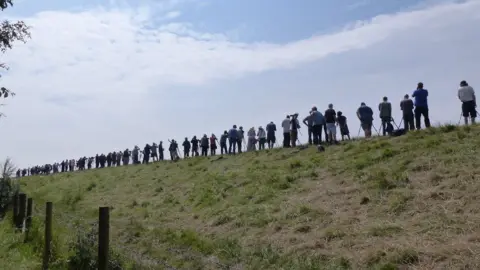Thousands flock to see 'very rare' little bustard
 Greg Dawes
Greg DawesThousands of twitchers have descended on a wildlife centre hoping to catch a glimpse of a bird not seen in Gloucestershire since 1946.
The little bustard was first spotted by Martin McGill at the Wildfowl and Wetlands Trust (WWT) on Sunday.
About 2,000 avid birdwatchers lined up for the "mega" sighting in Slimbridge.
Reserve warden Mr McGill said: "I did swear and use some very naughty words when I saw it but it's extremely rare."
The last reported sighting in the county of the chicken-sized bird was in May 1946 in Nortleach and in Britain in 2014.
 Martin McGill
Martin McGill Mr McGill said his first reaction when he spotted the "extremely rare" male bird "can't be published".
He said he thinks this rare visitor "may well stick around for a while".
"This is a mega sighting so we've probably had about 2,000 people by now," he said.
"It's of interest to lots of people so we're hoping it stays for the weekend."
Allow X content?

Tony Whitehead, from the RSPB, said the sighting was a "really good record for the UK" and would be "setting hearts aflutter".
"It's a pretty scarce bird, there have only been 27 visits by the little bustard to the UK since 1950," he said.
"But this last few days there has [also] been an influx of painted lady butterflies with the warm weather so it could be that very hot weather in France and Spain is causing a bit of movement."
Little bustards live and breed in grassland areas. There is a resident population in Spain, with migratory populations in France, Ukraine, southern parts of Russia and Kazakhstan.
